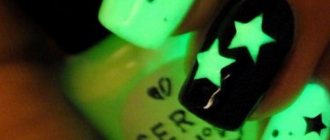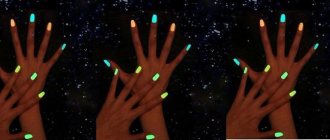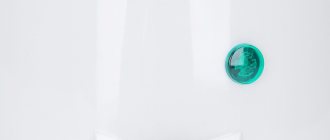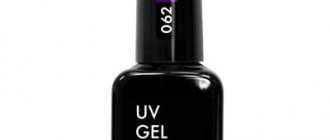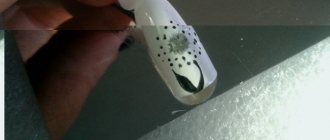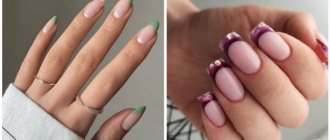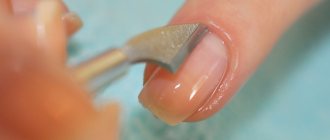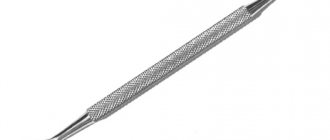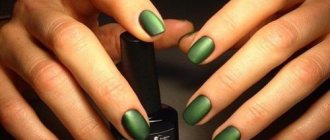At the disco, many people's manicures begin to glow brightly. But when the lights suddenly go out or when going outside, in a car or other places without special lighting, the manicure behaves differently: for some it continues to glow, for others it stops. Why does one polish glow in the dark and the other not? How to explain that in the light of advertising lights they behave the same? And most importantly: how to buy the right glowing polish?
In order to understand this, we should consider some physical phenomena. Everyone knows that phosphorus glows in the dark. In this case, a transition of the chemical type of energy into light occurs. But phosphorus compounds have long been banned for use in cosmetics. Why are some varnishes called phosphorus?
Why does nail polish glow in the dark?
Some substances have the ability to absorb light and then release it. This does not mean that they are light sources. On the contrary, in order for them to glow, they need to be placed under sunlight or a lamp. This effect is called luminescence. Translated from Latin “faint glow”. Luminescent varnishes glow in ultraviolet and neon lighting, which is used in discos and cafes.
Luminescence is divided into fluorescence and phosphorescence and differs in the duration of glow in the dark. Fluorescent varnishes immediately stop glowing when the light source is turned off, while phosphorescent varnishes continue to glow even in complete darkness. Gradually the intensity of the glow fades, but the polish glows in the dark all night long.
In the production of varnishes, cosmetics, fabrics, and designer paints, organic phosphors are used rather than phosphorus. They are safe, non-toxic and are even used in the production of children's toys. They accumulate light and release it in the dark, changing the wavelength to a shorter one.
Neon nail polish
Neon-based nail polish is primarily intended for all connoisseurs of club and nightlife who want to attract attention. This varnish has a bright, rich glow, allowing you not only to catch surprised glances, but also not to get lost in the crowd. Neon nail coating operates on the principle of reflection, that is, it can be seen either in sunlight or in ultraviolet radiation.
Description of luminous pigments
Colored pigments have appeared on sale, which are used for mixing with acrylic powders for nail extensions, sprinkling in designs and adding to top coats, both varnish and gel. Now there are dozens of phosphors that have different origins and costs. It is possible to industrially dye them in red, yellow, blue and green colors and shades.
The most commonly used substances in the production of glow-in-the-dark varnishes are:
- Sodium isothiocyanate, which is added for a light green glow. It has a short cycle and stops glowing quickly.
- Rhodamine glows red in the dark. It will also go out quickly.
- Strontium aluminate, giving a turquoise or yellow light. Lights up for 16 hours after “charging”. Now it is the most popular ingredient in varnish.
- Zinc sulfide – glows red-violet. A cheap component that is now being replaced by strontium aluminate.
The powder itself is opaque, its color is almost white with a greenish tint. In order for it to adhere to the surface, it is mixed with transparent varnishes. When dry, the coating with phosphors becomes matte. If desired, it can be coated with a glossy topcoat - this does not change the properties of the phosphors in a transparent medium.
What are phosphors
This word has two roots: the Latin lumen, meaning “light,” and the ancient Greek φορός, which means “carrying.” This is what they decided to call substances that convert energy into light. The process of glowing of such a substance is called luminescence.
Inorganic phosphors are used in the production of lighting devices, TV screens, and in x-rays and fluorography. Organic lumogens are involved in the creation of paints for plastic, textiles, various decorations, and cosmetics. This type includes a special LDP pigment, which contains glow-in-the-dark varnish. It is non-toxic and non-radioactive. Its use in cosmetic materials is safe.
Why does nail polish stop glowing in the dark?
Sooner or later the varnish stops glowing in the dark. As time passes, the glow of the phosphors stops and they go into a quiet state. Fluorescent varnishes stop glowing immediately. In order for the phosphorescent varnish to begin to exhibit its properties again, it needs to be “charged”: brought to a light source. Unfortunately, this is not useful for fluorescent varnishes.
When purchasing varnish, you should first place the bottle in the area of the light source - for example, under an incandescent or energy-saving lamp (not under a fluorescent lamp). Then the bottle is transferred to complete darkness or lowered into a box. Phosphorescent varnish glows in the dark.
How to choose the right varnish
The composition will tell you a lot - what kind of light the varnish glows can be seen from the pigment included in it. There are a lot of names for pigments, but the most commonly used in varnishes are the following:
- TAT 33, which glows brighter than the others and gives different colors when illuminated.
- MHB-4E, giving a turquoise glow.
- MHP-6D, which produces a purple glow.
Uncertified varnishes containing tritium are radioactive and their glow is dangerous. If the label does not indicate the composition, most likely the manufacturer has something to hide. Therefore, it is better to opt for products from well-known brands.
In daylight, phosphorescent varnishes have a dense texture and a matte surface. They are good for the office, but on vacation it is better to choose neon varnishes: they glow in the dark in the same way as other varnishes with phosphors, but in daylight they look much more advantageous. Phosphorescent pigment is added to the phosphors.
How to make nail polish glow
To make your manicure glow in the dark, you can apply a top coat with phosphor pigments. The light green pigment glows brightest. Manufacturers' recommendations for the ratio of pigment to clear varnish range from 1:1 to 1:10. In the production of paints, a ratio of 1:3 is used, where three parts of varnish are taken for one part of pigment.
After adding the powder to the varnish, it must be mixed well until smooth. When subsequently applied to the nails, the operation is repeated by shaking the bottle. If the pigment is applied unevenly, the glow will turn out ugly.
Video instructions will help you make your own nail polish that glows in the dark.
To make the manicure neater, luminous varnish is applied to a white base. This is followed by two layers of varnish with phosphors. Seal the coating with a glossy topcoat.
Glowing gel polish
In the dark, luminous nails with colored patterns look especially attractive. Some types of designs are difficult to achieve with regular varnish. Sometimes it’s easier to do this with gel polish. The phosphor and gel are mixed on the palette in a ratio of 1:4 - four parts of gel polish are taken for one part of pigment.
The advantage of directly preparing gel polish before application is that the pigment is well distributed over the entire surface. In the bottle it settles at the bottom and you have to shake it for a long time. Gel polishes have a thick texture; simply shaking the bottle (as when using regular polishes) may not help.
Many designs do this. One of them is ombre, stretching color and light. Stamping and stencil design look interesting against a luminous background. Some gel polishes, in particular El Corazon, contain luminous design elements - stars.
Fluorescent nail polish
Thanks to a number of positive properties, this type of nylon cosmetics is most popular among girls who want to give themselves a glowing manicure. This varnish is easy to use, dries quickly, is highly resistant to detergents, and adheres well to the surface of the nail, forming a shiny film. As for the glow effect, it has high brightness, but only in the presence of ultraviolet radiation. Also, fluorescent varnish has a huge variety of colors.
Brand names of glowing varnishes
The most famous domestic brand of fluorescent varnishes that glow in ultraviolet radiation is “Dance Legends”. There are a lot of color options for both the office and the disco. The second popular brand is Neil Art. During the day they look like regular polishes with glitter that glows green in the evening. Another good varnish is Jerden. Glowing varnishes are also produced by the brands “Patricia Nails”, “Smart Enamel”, “Masura” and others.
Gel polish that glows in the dark is produced by Global Fashion, Patrisa Nail, Rio Profi. To make the coating glow, it is kept in the light for several minutes. The cost of all brands is different, everyone can choose a suitable bottle.
Fascinating luminous coating design
Glowing nail polish is applied in the same way as regular nail polish. It can be used as a monotonous covering or to focus attention on a separate pattern that will attract the gaze of others in the dark. The colored jacket looks very original: the long “burning” tips look impressive and stylish. When using fluorescent nail polish, try experimenting with different shades. Paint each finger a certain color and enjoy the club music, surprising the girls and guys dancing nearby with a bright rainbow on their hands. Get interesting ideas for creativity in our photo collection.
Don't be upset if you mistakenly purchased, for example, neon nail polish instead of fluorescent one. After all, this is a good reason to get together with friends for a club party and amaze them with a new look! In conclusion, according to tradition, a short video tutorial with positive nail art for Halloween. Don't be afraid to stand out from the crowd and show the world what you can do!
